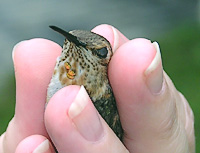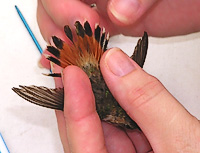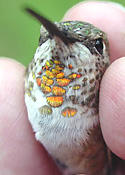
 Smaller than a rufous?; --photo ©Tiffany Hawkins
Smaller than a rufous?; --photo ©Tiffany Hawkins
| Hey! What's a blog anyway? |
September 10th, 2006
Migration of Ruby-throated Hummingbirds through St. Tammany Parish has been rather slow so far this year, so I didn't anticipate
large numbers at the Folsom Hummingbird Festival yesterday. However, our team trapped and banded 52 Ruby-throats by day's end.
Not a bad showing for the crowds of people who visited the Mizell's hummingbird and butterfly garden!
| ||||||||||||
October 20th, 2004
On this foggy morning I headed into the country, to a home west of Springfield, LA where an immature male Selasphorus
showed up a couple of days ago. After setting up the trap, the hummingbird didn’t understand what had happened to his favorite feeder!
  Smaller than a rufous?; --photo ©Tiffany Hawkins
Smaller than a rufous?; --photo ©Tiffany Hawkins
|
  One scruffy little bird! (Note the narrow primaries.); --photo ©Tiffany Hawkins
One scruffy little bird! (Note the narrow primaries.); --photo ©Tiffany Hawkins
|
This bird was one of the scruffiest young birds I’ve ever handled. His wings were faded and the edges of the feathers were worn. He had very little coloring on his back; most of those feathers were dusky and had no pigment at all. He was so ragged that, until I examined the corrugations on his bill, I wondered if the bird was an adult female who had a rough breeding season.
This confirmation of an Allen’s this early in the season is a rare event -- and it’s arrival couldn’t have happened to nicer folks.
September 11th, 2004
Banding Report - Folsom Hummingbird Festival
The weather was lovely; somewhat cool in the early morning and clear skies all day. A lot of people came out for the Festival,
and I was able to answer many questions about hummingbirds. Both children and adults were awed when they had a chance to
release a hummingbird.
Linda
Nancy
Totals Adult Male
10 12 22 Adult Female 12 15 27 Immature Male 16 16 32 Immature Female 8 14 22 Totals
46
57
103
During a break, I looked out over the grounds and saw families with blankets spread under the trees, their young children playing just out of arms reach. A scene from the City Park of my childhood.
I banded from 6:45am to 4:30pm. (Nancy Newfield banded as well, but I don't know her hours.) As usual, activity was slow during the midday hours. Karen Briley and Lu Robertson, from Michigan, spent the whole day in the garden trapping birds. Dagma Rider, Larry Wilson, and Laura Alexander each had a shift (or two) recording data. Also, Dave Patton made the trek from Lafayette to catch for Nancy and me.
About half of the birds had enough fat to consider them migration-ready. As usual for this time of year, we caught more immature males than any other age/sex combination. The table at the right shows the totals for the day.
August 21st, 2004
Hammond -- When Rusty Mahony saw an adult male Rufous in his yard a couple of days ago, he thought it might be “Mr Reliable”
who was banded there as an immature last winter. However, when Rusty saw a band on the bird’s right leg, he knew that
another bander had placed it there. (I've banded at Rusty's in the past but always on the left leg.)
This Rufous really wanted to enter the trap, but had a hard time getting into it. All those darn Ruby-throats kept chasing him away! During a lull, the Rufous managed to sneak in, take a sip... and get captured. After carefully recording the band number, I knew the first person to call — Dave Patton, since he bands on the right leg. Nope, not his band.
I posted a message on the Humbander list server and received a prompt reply from Fred Bassett. He banded this bird in Mobile, AL as an immature — on 1/18/03! Today was the first reencounter with this bird since it was banded as he had not returned to the Mobile yard last winter.
So, the big question is — where is this bird headed? Sadly for the Mahonys, he stayed only the rest of the day in Hammond. Perhaps some other lucky person in Mobile will have the honor of providing a winter home for this traveling Rufous.
July 29th, 2004
Slidell -- We’re still in the first half of Summer and the winter hummingbird season has already begun!
Today I banded the first Rufous of the 2004-05 season. When I received a phone call last night reporting a possible Rufous or Allen’s,
I was skeptical until I heard the description of the bird. The JPEGs I received shortly afterwards confirmed the identification
as an immature male Rufous. I was going to Slidell anyway, so I rearranged my plans to trap this early “winter” visitor.
What a delight to watch this young spitfire defend his part of the yard from the Ruby-throated!
Ahhh....those Rufous curses are music to my ears.
July 24th, 2004
St. Francisville -- The third Feliciana Hummingbird Celebration was another success!
Last night, Bill Fontenot gave a wonderful slide presentation showing birds and the natural food they eat throughout the year.
Both banding sessions went very well. Fortunately, numbers were good so almost everyone who attended had a chance to release
a hummingbird from their hands.
Nancy Newfield worked at the Butler site in St. Francisville. She banded 43 hummingbirds and recaptured a male that was banded at last year’s festival.
It was my fourth year to band on the 4th weekend in July at the Tunica site. I banded 55 hummingbirds and recaptured six birds that were banded in previous years. We also recaptured 19 birds that were either banded or logged as returnees at one of our earlier sessions during May and June. I was excited to reencounter these individuals, because I believe they are part of the breeding population in Tunica.
The sheer numbers of adult females captured in West Feliciana Parish show it has prime breeding habitat. Most of the adult females we captured had degrees of wear on the tips of their tail feathers. Hummingbird researchers note this wear, because it shows that the female was a likely breeder. When feeding young, the female props her tail against the side of the nest for stability, and over time, the feathers begin to wear. Nancy noted one adult female with a swollen abdomen; she might lay another clutch of eggs in the week following the festival. This is somewhat late but not abnormal.
June 6th, 2004
Abita Springs -- Blooming mimosas and trumpet vine signal the spring hiatus at our feeders.
Breeding season is in full swing. Females are busy feeding tiny bugs to their nestlings. Males are cruising the neighborhood.
It’s been difficult to catch many hummers these past two weeks. Although still slow, today was a red-letter one at the Clifton’s — we caught our first fledgling of 2004! He’s a young male with no gorget feathers and no fat. With no obvious presence of his mother, I suspect he’s been released from her care for at least a few days.
We also recaptured an adult male. He turned out to be our first returnee from this March -- and the first fledgling we banded last year! Amazing coincidence? Or "Type-A" hummingbird behavior?
May 1st, 2004
Abita Springs -- Today was a red letter day for capturing female Ruby-throated returnees that I had
not yet encountered this season. Perhaps the weather was a factor in our high capture rate; a cool front moved through the
area over the weekend.
Of seven female returnees, the three oldest birds were banded as adults in 2001. And one of these ladies had never been recaptured until today! Was she somewhere else in previous seasons? Or, is it more likely that we only catch a portion of the birds that actually return? It's always exciting when the babies come back in following years to breed. Two immature females I banded in 2002 I captured both last year and again yesterday. Each showed some signs of breeding.
April 27th, 2004
In looking over my data for the month of April, the biggest change is the increase from March in the number of females
captured. And, most of these females showed some sign of breeding readiness. I vusually check all females for swollen
vents and fluid on the abdomen. In past years, I’ve been elated to catch a few females where a clearly defined egg was
visible under the skin in the oviduct. No luck so far this year, but I’m still hopeful.
During my banding sessions in April our banding team was entertained by the aggression/courtship behavior of males. The males display to the females (sometimes other males, and even other species of birds!) with a magnificent “U” dive accompanied by a particular wing trill. If the object of his “affection” hangs around for the finale, he performs his ‘shuttle’ display — a more intimate, in-your-face flight also with sound effects. Always a pleasure to watch!
April 24th, 2004
Today was the last day Old Mama was seen in the Clifton's pocket garden. Before she left, it appeared she had completed
her molt and wore stunningly beautiful plumage. The pocket garden seems empty without her Rufous curses. We all hope
this cantankerous senior citizen returns next season!
April 4th, 2004
Regularly scheduled banding at the Cliftons' home in Abita Springs: 29 birds; 8 recaptures. One of the recaptures was an adult ruby-throat female that Nancy Newfield banded at the Cliftons' as part of International Hummingbird Day on August 15th, 1998 and has not been recaptured since. She exhibited symptoms of breeding.
An old bird, though not a record for a ruby. Still and again, this kind of site fidelity is unbelievable.
March 31st, 2004
Out early in my backyard this bright clear morning, I caught a nice female ruby throat with a band. Immediately, I recognized the band as one of mine, but I didn't realize the significance until I'd weighed and processed her and gone inside to check my records. I originally banded this girl in my yard on March 31st, 2003! Yup! Exactly one year to the day!!
Now, that doesn't mean she arrived the same day. But, I do try to notice new arrivals and get to them as promptly as scheduling with my other study sites permits. I don't think I could be off by more than a day or so. I'm constantly amazed that these tiny birds cover such spectacular distances and arrive back at the same feeder exactlly a year later. Amazing!
 Old Mama; --photo ©Dave Patton |